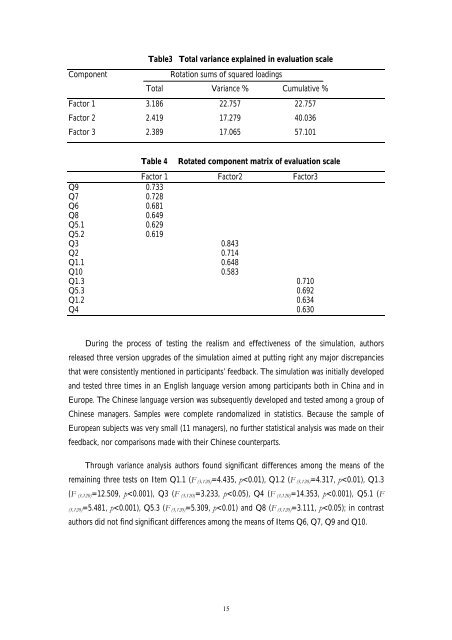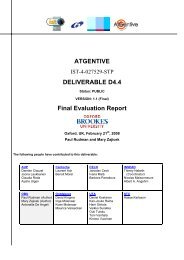LingHe Simulation - INSEAD CALT
LingHe Simulation - INSEAD CALT
LingHe Simulation - INSEAD CALT
You also want an ePaper? Increase the reach of your titles
YUMPU automatically turns print PDFs into web optimized ePapers that Google loves.
Table3 Total variance explained in evaluation scale<br />
Component<br />
Rotation sums of squared loadings<br />
Total Variance % Cumulative %<br />
Factor 1 3.186 22.757 22.757<br />
Factor 2 2.419 17.279 40.036<br />
Factor 3 2.389 17.065 57.101<br />
Table 4<br />
Rotated component matrix of evaluation scale<br />
Factor 1 Factor2 Factor3<br />
Q9 0.733<br />
Q7 0.728<br />
Q6 0.681<br />
Q8<br />
0.649<br />
Q5.1 0.629<br />
Q5.2 0.619<br />
Q3 0.843<br />
Q2 0.714<br />
Q1.1<br />
0.648<br />
Q10 0. 583<br />
Q1.3<br />
Q5.3<br />
0.710<br />
0.692<br />
Q1.2<br />
Q4<br />
0.634<br />
0.630<br />
During the process of testing the realism and effectiveness of the simulation, authors<br />
released three version upgrades of the simulation aimed at putting right any major discrepancies<br />
that were consistently mentioned in participants’ feedback. The simulation was initially developed<br />
and tested three times in an English language version among participants both in China and in<br />
Europe. The Chinese language version was subsequently developed and tested among a group of<br />
Chinese managers. Samples were complete randomalized in statistics. Because the sample of<br />
European subjects was very small (11 managers), no further statistical analysis was made on their<br />
feedback, nor comparisons made with their Chinese counterparts.<br />
Through variance analysis authors found significant differences among the means of the<br />
remaining three tests on Item Q1.1 (F (3,120)=4.435, p
















